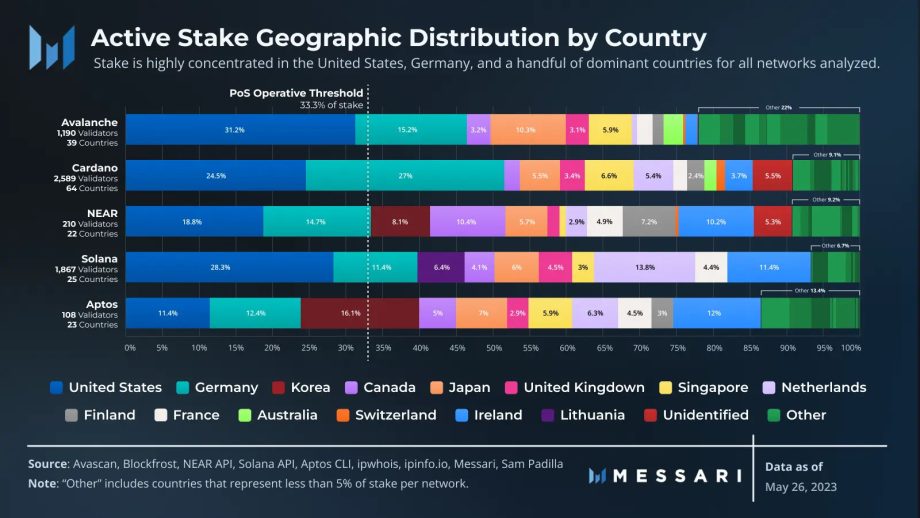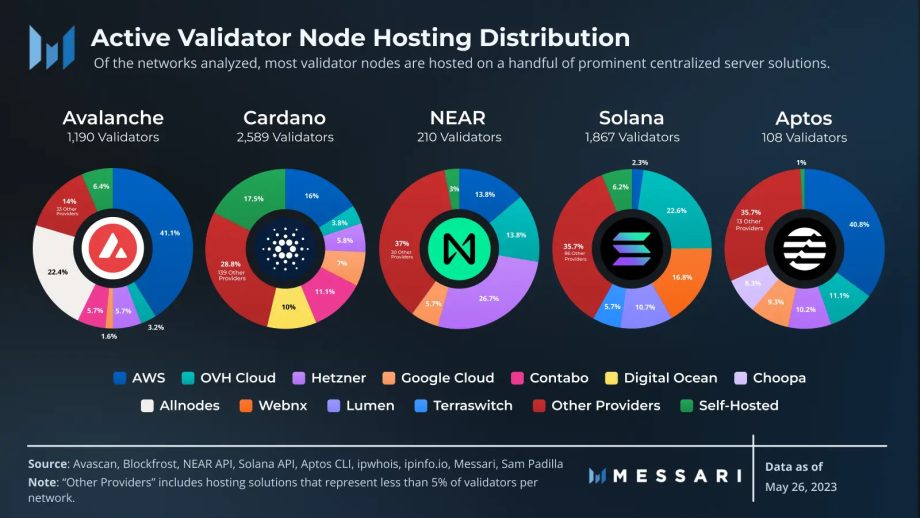The promise of the blockchain is clear: it is transparent, immutable and above all – decentralized. This is what the supposed “alternative Layer 1 networks”, from Avalanche to Solana, advertise in particular. But actual decentralization is hard to see. So far, the Nakamoto coefficient, which determines the number of nodes required to disrupt a blockchain network, has often been used for this.
But other factors also play a role, such as a recent report by crypto analysts Messari shows. This includes the geographic location of individual validators, as well as the hardware and software infrastructure used. These provide information about how decentralized the corresponding blockchain is really built and how vulnerable it is to regulatory measures in individual countries or cyber attacks, for example.
“Operational Decentralization”
The term “operational decentralization” can be derived from this. It includes values for staking concentration, distribution of validators, choice of hosting infrastructure and number of software clients. Avalanche, Cardano, NEAR, Solana and the blockchain newcomer Aptos are considered and compared in these matters. They are all proof-of-stake (PoS) networks that are considered possible alternatives to Ethereum by their developers and community.
The most important links of a PoS network are its validators. Not only the number of these, but also how they are hosted is crucial for decentralization. However, most blockchain validators are based on central server services such as Amazon Web Services (AWS), Google Cloud or the German provider Hetzner. Very few host at home.
Winner in this category: Cardano. With around 2,500 nodes, the blockchain not only has the most validators, but also sees them best distributed among all hosting providers. Around 17.5 percent of the validators are even hosted from home – the best value among all chains. In contrast, 63 percent of all Avalanche nodes are spread across just two hosting providers, with 43 percent on AWS. If the Internet giant’s infrastructure goes down, what happened more often, nearly half of Avalanche nodes are at risk of going offline. Aptos and NEAR, meanwhile, have the lowest number of validators.
Blockchain – a worldwide network?
What good is a large number of validators if they are all in one country? The example of Bitcoin shows that country concentration can become a problem. According to this, a majority of the miners were once in China. However, when the government there declared war on crypto, the hashrate of the network collapsed for a short time and led to an exodus of miners.
The better a network is distributed across several countries, the better the protection against similar measures. However, all analyzed blockchains are one-sided in these matters. Europe and North America dominate here for all projects, with Avalanche recording the largest node distribution in other regions. According to Messari, the most popular country for validators is the USA, followed by Germany. After all, Cardano distributes its validators across 64 countries. At NEAR there are only 22.
For PoS networks, it is also important to note that not only the node distribution worldwide, but the concentration of the stake in the countries is crucial. More than 50 percent of ADA coins are staked in the US and Germany – a general trend. Only Aptos opposes this. Aptos’ validators therefore stake around 16 percent of the coins in South Korea, which gives a more even distribution.

bottom line
According to Messari, all of the Layer 1 networks examined leave room for improvement in terms of decentralization. Accordingly, the most common way for many blockchains to launch a validator is on an AWS server in the US. This makes you vulnerable to failures of the hosting provider and local regulatory measures.
Cardano and Solana stand out in that despite the regional concentration, the staked coins of the two blockchains are distributed among most hosting providers. As a result, you are least dependent on a single service such as AWS. Both also count a high number of validators.
As a result, Solana gets the highest “operational Nakamoto coefficient” of 1.9. This is followed by Cardano and Aptos with 1.6 and Avalanche and NEAR with 1.3. As a rule of thumb, the higher the value, the better the decentralization. But Messari’s verdict is clear: Fewer than two mutually independent vulnerabilities must fail in order to disrupt the respective networks. Consequently, all blockchains remain somewhat vulnerable, which is reflected in past news of outages, disruptions, and bugs. So although some have made progress in decentralization, they cannot rest on their laurels just yet.
The latest issues of BTC-ECHO Magazine
You might also be interested in this
